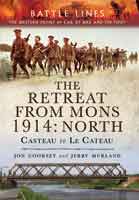![]() The Retreat From Mons 1914: North by Jon Cooksey & Jerry Murland (Pen & Sword 2014, ISBN 978 1 78303 038 5, 157pp, paperback, illustrated, £14.99)
The Retreat From Mons 1914: North by Jon Cooksey & Jerry Murland (Pen & Sword 2014, ISBN 978 1 78303 038 5, 157pp, paperback, illustrated, £14.99)
Jon Cooksey is editor of Stand To! and Jerry Murland has written several books about the British Army in 1914 and this volume is part of a series the authors have been working on covering largely lesser known battlefields of the Great War. Starting with a brief background to the British Army in 1914, some historical context and visitors information, the bulk of the book covers four main tours looking at different aspects of the Mons battlefields. This takes in the Mons area itself but also the early stage of the Retreat From Mons down to the battlefield at Le Cateau. Text is clear and the book goes into some detail with lots of human interest stories. There are good, clear maps and is well supported by contemporary images as well as colour modern ones. Mons has lacked a good battlefield guide for some time and this certainly fills the gap taking the visitor to some well known sites and also some lesser known ones. A fantastic Mons battlefield guide and essential reading for anyone going to Mons for the Centenary this August.
The book is available from the publisher’s website.
![]() Ypres 1914: Langemarck by Jack Sheldon & Nigel Cave (Pen & Sword 2014, ISBN 978 1 78159 199 4, 208pp, paperback, illustrated, £12.99)
Ypres 1914: Langemarck by Jack Sheldon & Nigel Cave (Pen & Sword 2014, ISBN 978 1 78159 199 4, 208pp, paperback, illustrated, £12.99)
The authors have produced a number of Battleground Europe books looking at familiar Great War battlefields from a German perspective based on the research done by Jack Sheldon in German archives and unit histories. This volume looks at Langemarck, a village associated with a great deal of myth when it comes to the German experience of WW1 as the Nazis peddled the myth that the cream of Germany’s youth suffered a futile death here in the First Battle of Ypres. The bulk of this book is history rather than guidebook and nearly 130 pages cover the fighting in some depth with insights from both the British and German perspective. It is well illustrated, with many photos from German sources and thus lesser known. The tour section suggests four battlefield routes which cover areas much wider than Langemarck itself, and again there are good illustrations and maps to accompany this. My only criticism is that I could not find any mention of the symbolism of Langemarck to the next generation, nor any debate about the Lanhemarck - which was odd considering the book is more history than battlefield guide. Having said that it is a useful book for anyone wanting to look at an aspect of First Ypres in depth or visit the battlefields from a different perspective.
The book is available from the publisher’s website.
 The Retreat From Mons 1914: North by Jon Cooksey & Jerry Murland (Pen & Sword 2014, ISBN 978 1 78303 038 5, 157pp, paperback, illustrated, £14.99)
The Retreat From Mons 1914: North by Jon Cooksey & Jerry Murland (Pen & Sword 2014, ISBN 978 1 78303 038 5, 157pp, paperback, illustrated, £14.99) Ypres 1914: Langemarck by Jack Sheldon & Nigel Cave (Pen & Sword 2014, ISBN 978 1 78159 199 4, 208pp, paperback, illustrated, £12.99)
Ypres 1914: Langemarck by Jack Sheldon & Nigel Cave (Pen & Sword 2014, ISBN 978 1 78159 199 4, 208pp, paperback, illustrated, £12.99)